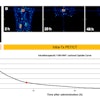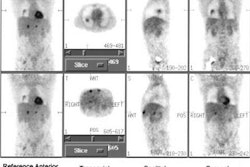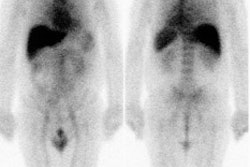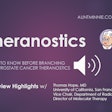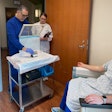Two long-term imaging studies are providing more evidence that dopamine agonists are superior to levodopa for the initial treatment of Parkinson's disease patients. One group of researchers looked at the motor function of these patients, while another other group investigated the drugs' effects in younger patients.
"My study is the first example in which we have evaluated the progression of Parkinson's disease, (showing) there is a difference in brain activity as a result of a treatment," said Dr. Kenneth Marek, president of the Institute for Neurodegenerative Disorders in New Haven, CT. Marek spoke at the 2002 American Academy of Neurology meeting in Denver.
Marek's group undertook a substudy of a larger trial looking at motor-function complications in patients taking either pramipexole or levodopa. The substudy included 42 patients taking pramipexole and 40 patients on levodopa, who underwent SPECT scanning to determine progression in the depletion of dopamine transporter in the brain.
Patients were injected with the dopamine transporter imaging agent b-CIT -- a radioactive iodine-tagged cocaine analog -- and were serially screened with SPECT at baseline, and three more times during the four-year study.
Marek said dopamine transporter levels decreased by 25% at baseline in levodopa patients; the decrease was 16% with pramipexole. Dopamine transporter levels decreased about 7% a year compared with 4% a year with pramipexole.
"Patients treated initially with pramipexole demonstrated a relative reduction in the rate of loss of striatal b-CIT uptake of approximately 40% compared to those treated initially with levodopa during a 46-month evaluation period," Marek said. "These imaging data strongly suggest that treatment with pramipexole may slow and/or levodopa may accelerate the rate of loss of nigrostriatal dopamine neurons in early Parkinson's disease patients."
In a second report, PET scans were used to compare treatment with ropinirole to levodopa. In this study, dopamine transporter levels declined by 20% with levodopa, and by 13% with ropinirole -- a relative risk reduction of about 35% over the two-year study.
Author Dr. Ray Watts, professor of neurology at Emory University in Atlanta, said dopamine agonists should be the first-line treatment for younger patients. At the same time, elderly individuals with comorbidities might do well on levodopa, since there could be a heightened risk of undesirable side effects in older people with the dopamine agonists, he said.
Taken together, the studies indicate that dopamine agonists should be front-line treatment for most newly diagnosed Parkinson disease patients, Marek said.
"Most neurologists already prescribe dopamine agonists first," commented Dr. Abraham Lieberman, medical director of the National Parkinson's Foundation and a professor of neurology at the University of Miami in Florida. "However, it appears that this message hasn't yet reached internists and family practitioners, who treat about half the Parkinson's patients in the United States. These studies may help convince them to change the way they practice."
By Edward SusmanAuntMinnie.com contributing writer
May 20, 2002
Related Reading
Sympathetic nerve damage observed in Parkinson's disease, April 23, 2002
SPECT imaging can assess effect of Parkinson's disease treatment, April 3, 2002
Copyright © 2002 AuntMinnie.com



